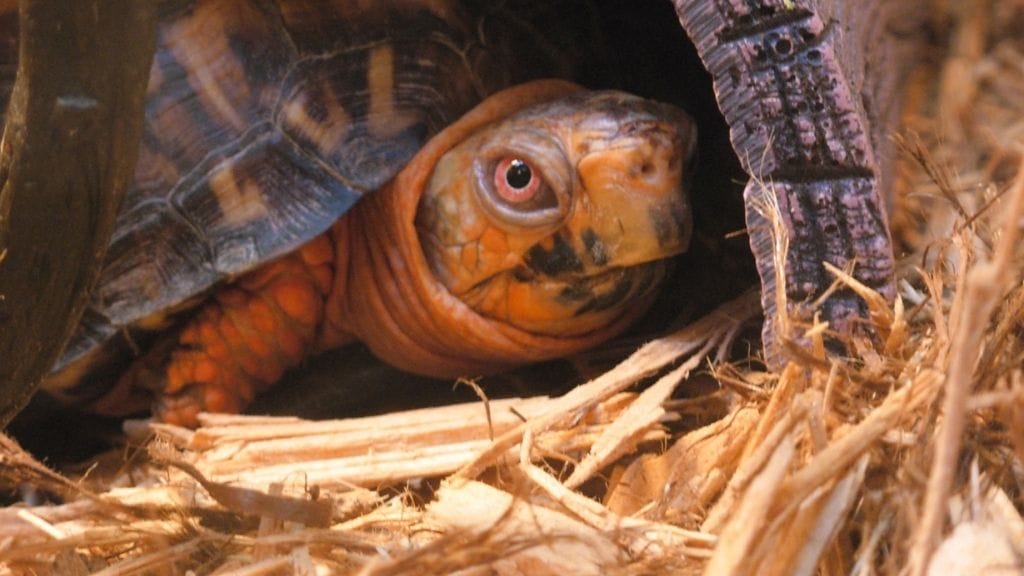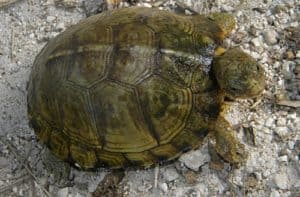Terrapene carolina carolina (Eastern Box Turtle)
Home > Turtle Database > Terrapene carolina carolina (Eastern Box Turtle)

The Eastern Box Turtle (Terrapene carolina carolina) is a small, terrestrial turtle known for its high-domed shell and ability to close itself completely using a hinged plastron. Native to the eastern United States, it is a long-lived species often found in forests and grasslands, where it thrives in humid environments.
Native To These Regions
Alabama (USA), Arkansas (USA), Connecticut (USA), Delaware (USA), Florida (USA), Georgia (USA), Illinois (USA), Indiana (USA), Iowa (USA), Kansas (USA), Kentucky (USA), Louisiana (USA), Maine (USA), Maryland (USA), Massachusetts (USA), Michigan (USA), Minnesota (USA), Mississippi (USA), Missouri (USA), New Hampshire (USA), New Jersey (USA), New York (USA), North Carolina (USA), Ohio (USA), Oklahoma (USA), Pennsylvania (USA), Rhode Island (USA), South Carolina (USA), Tennessee (USA), Texas (USA), Vermont (USA), Virginia (USA), West Virginia (USA), Wisconsin (USA)Native Turtle Species Map – Find Turtles by Region
Scientific Classification
Kingdom: Animalia
Phylum: Chordata
Class: Reptilia
Order: Testudines
Family: Emydidae
Genus: Terrapene
Species: Terrapene carolina
Subspecies: T. c. carolina
Common Names
Eastern Box Turtle
Common Box Turtle
This Hilarious Turtle Book Might Know Your Pet Better Than You Do
Let’s be real—most turtle care guides feel like reading a textbook written by a sleep-deprived zookeeper.
This one’s not that.
Told from the snarky point of view of a grumpy, judgmental turtle, 21 Turtle Truths You’ll Never Read in a Care Guide is packed with sarcasm, sass, and surprisingly useful insights.
And hey—you don’t have to commit to the whole thing just yet.
Grab 2 free truths from the ebook and get a taste of what your turtle really thinks about your setup, your food choices, and that weird plastic palm tree.
It’s funny, it’s honest, and if you’ve ever owned a turtle who glares at you like you’re the problem—you’ll feel seen.
Identification
Description
The Eastern Box Turtle has a domed, oval-shaped carapace with a variable color pattern of yellow, orange, or brown markings on a dark background. The plastron is hinged, allowing it to close completely when threatened. The skin is dark brown or black with yellow or orange spots, and the legs are short and sturdy.
Sexual Dimorphism
Males usually have red or orange eyes, a concave plastron, and a longer, thicker tail. Females typically have brown or yellowish eyes, a flat plastron, and a shorter tail. Males also have longer, more curved hind claws.
Check more turtles from the Terrapene genus
Native Origin and Distribution
Geographical Range
The Eastern Box Turtle is native to the eastern United States, from Maine to Florida and as far west as the Mississippi River. It is most common in the Appalachian region and the southeastern states.
Preferred Habitat
This species prefers deciduous forests, meadows, and wetland edges. It thrives in areas with high humidity, loose soil, and access to water sources such as ponds or streams. It often burrows under leaf litter to regulate its temperature and avoid extreme weather.
Behavior
Feeding Habits
The Eastern Box Turtle is an omnivore with a diet that includes insects, worms, snails, fungi, berries, and plants. Younger turtles tend to eat more protein, while adults consume more plant material.
Predators
Common predators include raccoons, foxes, skunks, birds of prey, and snakes. Hatchlings and juveniles are especially vulnerable due to their softer shells.
Reproduction
Breeding Season
Mating typically occurs in spring and early summer, often after rainfall.
Reproductive Method
Females lay 3-8 eggs in shallow nests, usually in sandy or loamy soil. Incubation lasts around 70-90 days, and the temperature determines the hatchlings’ sex, with warmer nests producing more females.
Conservation
Extinction Status
The Eastern Box Turtle is listed as vulnerable in many states due to declining populations.
Threats
Habitat destruction, road mortality, collection for the pet trade, and climate change are major threats. Since they have low reproductive rates and slow growth, populations struggle to recover from declines.
Conservation Measures
Legal protections exist in several states, and conservationists focus on habitat preservation, road-crossing awareness programs, and captive breeding initiatives. Many states prohibit the collection of wild specimens.
Economic Importance
The Eastern Box Turtle has minimal economic significance, though it is sometimes kept as a pet. Due to its specialized care requirements and long lifespan, it is not commonly recommended for captivity.
Interesting Facts
- Eastern Box Turtles can live over 100 years, though most in the wild average around 40-50 years.
- They have a homing instinct and will attempt to return to their original territory if relocated.
- They can survive cold winters by burrowing into the ground and entering brumation, a hibernation-like state.
- Their hinged plastron provides excellent protection against predators, making them one of the few fully closable turtles.

About Author
Muntaseer Rahman started keeping pet turtles back in 2013. He also owns the largest Turtle & Tortoise Facebook community in Bangladesh. These days he is mostly active on Facebook.














